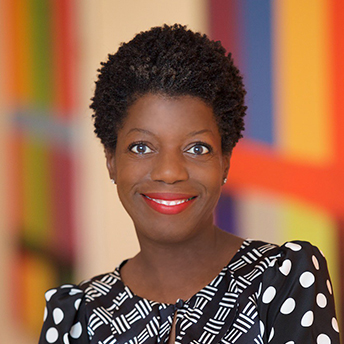

Thelma Golden used to be mistaken for her own assistant. But these days, there aren’t many in the art world who don’t know the 50-year-old director and chief curator of the Studio Museum in Harlem.
Twenty-five years ago, before her closets were written up in O magazine and her 2008 wedding featured in Vogue, Golden was a young curator at the Whitney Museum — its first black curator, actually. Her looks didn’t match people’s assumptions about who got to be a mover and a shaker in the world of art. But Golden, who has a knack for turning setbacks into ambition, now calls those early cases of mistaken identity “liberating.”
“It allowed me the opportunity to not only create a deep impression,” she says, “but also was a way that I personally made goals that moved me toward being known and being understood.” Golden is quite small, with close-cropped hair and an earnest face. Today, in her office at Studio, she’s wearing a bold print dress created by her fashion designer husband, Duro Olowu. There’s no mistaking her for anyone else.
Increasingly, Golden is becoming known beyond the realm of curation. Last year, she was seated next to President Obama at a White House state dinner, leading a flurry of people to ask, “Who was that woman?” Let culture critic Greg Tate, profiling Golden in the Village Voice years ago, answer it: “A stone-cold player. A highbrow mack-diva of the first magnitude.”
In the summer, she was appointed to the board of directors of the Barack Obama Foundation, which will erect his presidential library on Chicago’s South Side, leading one critic to speculate — Golden is this revered — that she might be “too good” for the job. Shortly before that, Studio announced that it would soon be starting construction on a bigger, $122 million home, yielding stories about the growing importance of the museum and its charismatic director.
Throughout her career, Golden has proved adept at putting together shows about race and identity that are deeply controversial at the time but years later, look prescient. Studio was founded almost 50 years ago as a showcase for important black artists who had been left out of the official (read: white) canon, and Golden’s relationship with the museum stretches back to her days as a college intern there, plus a year after college before she joined the Whitney. When Golden returned in 2000 as Studio’s deputy director, art critics knew the institution as sleepy and genteel; she helped to boldly reshape it. Her first major contemporary exhibition, “Freestyle,” announced the dawn of the “post-black” era — a movement of artists who no longer wanted to be explained or contained by the label “black,” even as they were steeped in racial consciousness. The New Yorker pronounced the museum “post-Golden.” In 2005, Golden became its director.
Golden has cultivated deeply personal relationships with many of the artists she has championed, becoming so close with one that she witnessed the birth of her child.
“As a curator, I’ve always understood my curatorial practice as being highly collaborative with artists,” says Golden, whose run-on sentences sometimes have a Zen quality. “There’s a story for each of them. I know exactly when I first saw the work, or came to understand how I understood the work — or how maybe I didn’t understand the work and that’s what moved me into a conversation with them.”
Now, a decade into helming Studio, Golden is no longer directly curating shows. Instead, she is in what she calls the “institution-building” phase of her career. She lives a few blocks from the museum, and has constructed a travel-heavy, cross-continent marriage with her Nigerian-born, London-based husband. She’s charismatic, but seems guarded compared with her persona in older interviews, in which she brimmed with audaciousness — perhaps because she’s mellowed or because of the heat she has felt in her career for being a first.
(Read more at New York Times)
